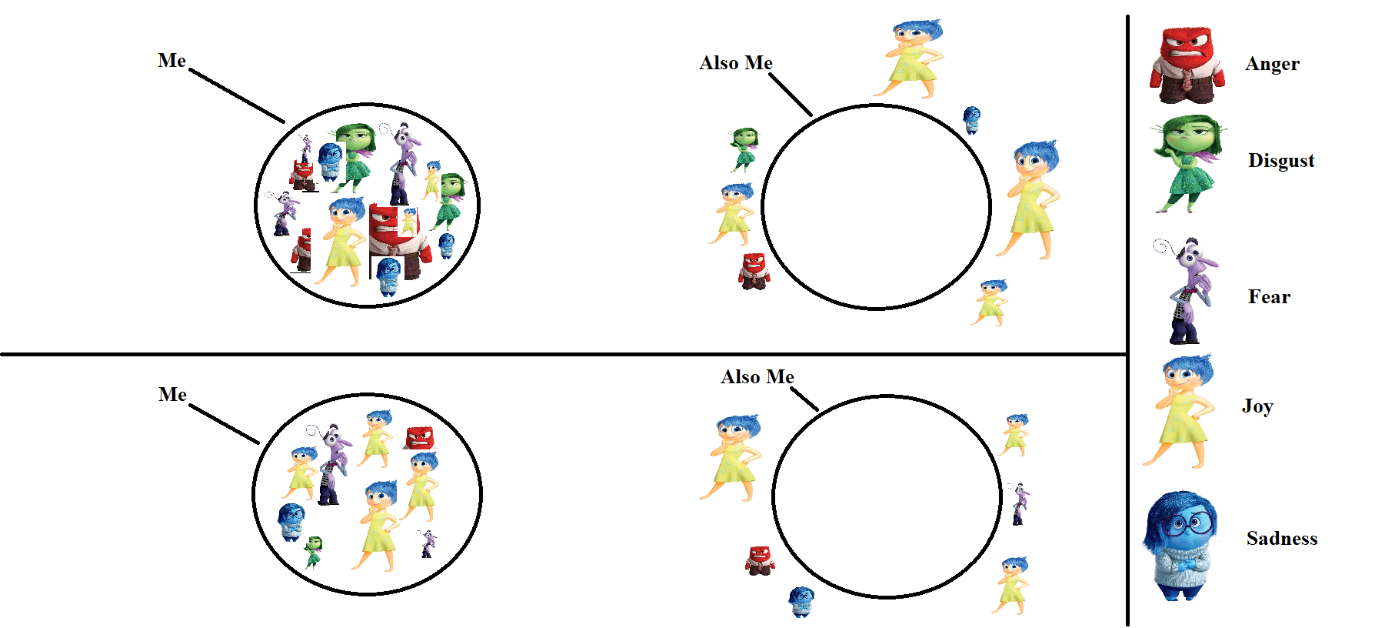The way people are seen by others is likely to differ from how each person views themselves. Nabigon (2006) proposes that an individual can be characterized by two aspects, which are their external (ES) and inner (IS) selves. The word “persona” can be used to describe the former, and ES is the image displayed to the outside world (Nabigon, 2006, p. 93). On the other hand, IS refers to a person’s private feelings and thoughts (Nabigon, 2006). Although what an individual shows others may seem distinct from one’s internal qualities, ES and IS are interconnected and may lead to an imbalance in life without proper care (Nabigon, 2006). My IS and ES have some discrepancies, which are depicted through a collage, but I have become better at listening to myself after participating in the program.
A visual I have created to illustrate my ES and IS has two parts. Picture 1 demonstrates a collage of my emotions that I show to others and keep to myself, with the above two circles representing me before the program and the ones below depicting me now. To assemble the visual, I used images of characters that portray different sentiments from the movie Inside Out (Ibrahim & Junaid, 2021). I understand that people’s feelings are quite complex, but the five emotions seem practical for the collage’s purpose of exhibiting my IS and ES.

The collage demonstrates who I am based on my feelings and what part of me I display to the world. It is important to mention that I moved to Sioux Lookout, Ontario, nine years ago for work. Now, I am a supervisor for child care and family services in Muskrat Dam, and I have two teenage sons. Prior to starting the program, I had a variety of emotions, and negative ones often overpowered those that were positive. For example, I tried to suppress my anger and fear, and although I was happy, I had pessimistic thoughts. However, as a mom and a professional working with children, I felt obligated to show that I was cheerful and brave. Occasionally, I would demonstrate some bitterness and be judgmental toward others and myself. Accordingly, my ES did not correspond with IS, causing an imbalance.
Approaching the program’s end, I have discovered how to address my feelings better. I have realized that I was controlled by harmful experiences in my past and frequently was tired but did not know how to bring order to my life. I took the program to move up in my organization and learn more about Indigenous culture, but the lessons helped me understand better that I need to find inner peace. Nabigon (2006) states that individuals take care of their IS through personal reflection, which I now strive to practice daily. Moreover, Nabigon (2006) suggests that people are responsible only for their own happiness and should not attempt to influence others or solve their problems. Consequently, I no longer try to suppress my emotions but accept them and look for the reasons behind them. As a result, I am more at peace and do not feel the need to judge or demonstrate that I am always happy and fearless. Sometimes, I let go of my anger or sadness but in ways that do not harm others. Accordingly, I am now learning to take care of my IS and ES.
To conclude, the visual collage depicts my inner and external selves, which have transformed since the start of the program. I have discovered more about how to understand myself and interact with the people in my life. Although I am not in my perfect state, I believe that by implementing the insights from the program, I can nourish my IS and ES further and find balance.
References
Ibrahim, W. A., & Junaid, S. (2021). Emotional intelligence in “Inside Out” movie. Journal of Advanced English Studies, 4(2), 46-51. Web.
Nabigon, H. (2006). The hollow tree: Fighting addiction with traditional native healing. McGill-Queens University Press.